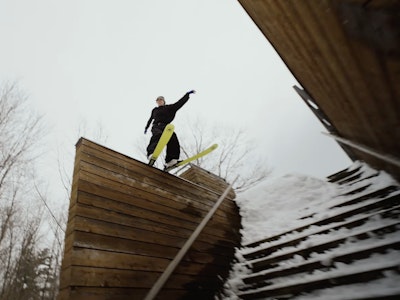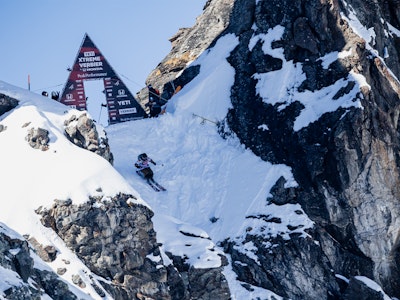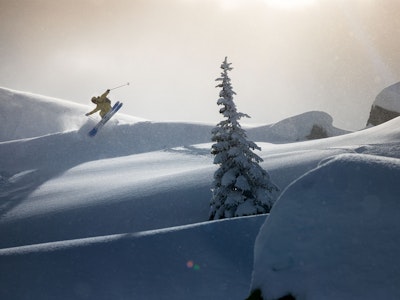With the many advances in ski technology over recent years, choosing the right pair of boards has not gotten any easier. Today’s countless designs excel in different areas and choosing the right pair boils down to how and where you like to ski. While you may not know exactly what skis you need, you probably have a good idea of what you want them to do.
Read reviews of all of the best skis of 2012/2013.
Before you start looking to buy skis, prioritize the areas of performance you’re looking for and compile a list of your desired attributes. Are you looking for something that will carve pipe walls with precision? Do you need something burly to stomp those cliff hucks or are you more interested in a ski that will be playful in the powder? Maybe you want a ski that will do all of these things. Rank them in order of importance. This quick exercise will help you focus in on what you really need for a more effective ski-buying process.
While you can research and shop for days on end, the one true way to know how a ski performs is to ski on it. If possible, pay for a full day demo from your local shop where they will usually let you try out as many pairs as you want in that time, and may apply the cost towards whatever pair you end up buying. Better yet, look for company demo days and do it for free. Be sure to take at least two runs on each ski, and if your research paid off, one of the skis you try should click. Like love, you’ll know it when you feel it.
Shape
Never forget that shape is king and should always be your starting point. Begin by selecting an appropriate waist width for the terrain you will be on most of the time. As a general guideline: 75 to 95 mm for park, pipe and most East Coast skiing, 95 to 115 mm for all-mountain and big-mountain lines, and 115 mm or more for powder hunting. Not to say that you can’t ski a 100 mm ski in the park or that you won’t have a blast crushing powder with a 107 mm waist, but these widths are a good starting point.
Next comes sidecut. A traditional sidecut, resembling an hourglass, is great for carving and lends itself well to the park and pipe. Outside of these types of shredding however, you might benefit from some of the more progressive designs available. Multi-dimensional sidecuts, such as the popular 5-dimensional Rossignol S7s and Armada JJs, provide wide, float-friendly widths near the main contact points and tapered sidecuts in front and behind those points to alleviate tip hooking in deep snow whilte increasing performance. This kind of shape is great for off-piste skiing but still performs well all over the mountain.
Last but not least in the shape category is the camber vs. rocker decision. Traditional camber is the slight, upward curvature of an unweighted ski as it sits on a flat surface. This design will distribute the weight of a skier evenly along the edges for precision turning and great edge hold on groomed surfaces. A fully rockered ski has the opposite profile and the weight of a skier will cause the tip and tail to rise. This makes for great float in powder and easy maneuverability (turn initiation, schmear turns, and buttering), as the effective edge of the ski is much shorter. Clearly there are benefits to both designs and so many of today’s skis are a hybrid of the two: traditional camber underfoot and rocker in the tip and/or tail. This is a great formula and makes for a playful ski that will handle all conditions well but you need to decide how much of each design you want to incorporate. As Steve Kopitz of skis.com points out, “Subtle tweaks can make a huge difference in the way a ski performs.” A few millimeters of more or less camber can have a significant effect on the carving prowess of a ski and this is where you have to decide which areas of performance rank higher for you.
Core Construction
Different layers of materials dictate the vibrancy of a ski and should also be matched to your style of skiing. A variety of ingredients can be used to achieve this but wood should be at the core of a well-constructed pair. Vertically laminated strips of assorted flavors are used in different combinations to achieve varying flex patterns. Beech and poplar can be used for a poppy, lively feel while ash and fir provide a firmer flex. From there, other layers and materials can be added above and below the core to augment performance and dampen vibration. Look for tightly woven fiberglass and metal, such as titanium, to add stability and dampening properties in high-performance skis. Rubber is also used to dampen vibration and carbon fiber can be added for lightweight strengthening with a lively feel.
One thing you’ll notice among ski companies is that they love to make up words. These buzz words exist to make their technology sound exciting, which it usually is, but you need to cut through those terms to figure out what materials and processes lay beneath. If you see or hear a particular term you don’t understand, ask the guy at your local ski shop to break it down for you so you can make a more informed decision.
With so many different cores on the market it may not be possible to try them all out but you should flex all the skis you can get your hands on. Get a feel for the varying degrees of stiffness that come with different materials and narrow it down to what will suit your skiing best.
Sidewalls
Sandwich sidewalls are made of various, durable plastics and protect the core of your ski from impacts and moisture, while efficiently transferring energy to your edge. They are vertical, or slanted to save weight, and also help reinforce the edge against impacts brought on by rocks and rails. Some of the plastics used are higher quality than others, but Mike McCabe of Folsom Custom Skis says, “As a general rule of thumb, go with sandwich construction for a more durable, long lasting ski.”
Cap construction–where the top sheet and composite layer fold over the side and down to the edge–was popularized in the ‘90s due to its economical and forgiving qualities. While it won’t give you the performance of a sandwich sidewall, the forgiving nature and easy turn initiation make it good for some beginner-to-intermediate skis. It can also be used in hybrid construction, sometimes referred to as “half-cap” or “mini-cap,” where a sandwich sidewall is built and then capped. This is an effective use of both methods as it alleviates the sharp top edge, which is susceptible to gouges from the opposite ski but retains the performance of a sidewall underneath.
Another effective and increasingly popular hybrid is one that utilizes a sidewall underfoot with cap construction in the tip and tail to reduce swing weight.
Conclusion
We could write a book about ski construction but these are the most important pieces of the puzzle. Remember that shop employees live and breathe the newest gear so you don’t necessarily have to. Take the time to talk to them, ask questions and explain what your needs are. With your list of priorities and the knowledge provided by your local gear junkie, you’ll be on the right pair of boards in no time.
Ready to shop? Check out our reviews of all of the best 2012/2013 skis.



![[GIVEAWAY] Win a 4-Night Karma Campervan Rental and go Ski the Powder Highway](https://www.datocms-assets.com/163516/1767816935-copy-of-dji_0608-1.jpg?w=200&h=200&fit=crop)


![[GIVEAWAY] Win a Legendary Ski Trip with Icelantic's Road to the Rocks](https://www.datocms-assets.com/163516/1765233064-r2r26_freeskier_leaderboard1.jpg?auto=format&w=400&h=300&fit=crop&crop=faces,entropy)





![[GIVEAWAY] Win a 4-Night Karma Campervan Rental and go Ski the Powder Highway](https://www.datocms-assets.com/163516/1767816935-copy-of-dji_0608-1.jpg?auto=format&w=400&h=300&fit=crop&crop=faces,entropy)

